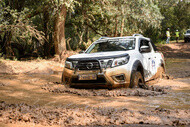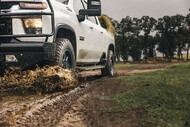
Mud Driving Tips for Your Off-Road Vehicle
Mud Driving Tips for Your Off-Road Vehicle
While mud driving may appear exhilarating for an off-road enthusiast, we encourage you to consider alternatives unless absolutely necessary. It’s a chance to preserve your vehicle and avoid the possibility of getting stuck for hours. However, if you insist on mudding with your trusty 4WD, we have some tips you might need.
Preparation for Mud Driving
When navigating soft and muddy ground, vehicles may experience reduced traction, leading to tire spinning without going anywhere. Therefore, it is essential to prepare before engaging in mud driving.
Check Your Tires
When you are driving through the mud, it's essential to consider both the type of tires and the air pressure. Use mud terrain tires with deep treads for better grip. Ensure that your 4WD tires are properly inflated and have enough tread depth. Dropping tire pressure slightly can help increase traction.
Carry Essential Equipment
Make sure to pack a recovery kit that includes essential tools such as a foldable shovel, a snatch block, snatch straps, traction boards, and D-shackles for when you find yourself stuck in mud. It's also a good idea to bring a portable air compressor to quickly reinflate tires if needed.
Practice Using Recovery Tools
Familiarity with these tools enhances your ability to respond effectively when challenges arise.
Always Travel With a Buddy
When traveling, it's advisable to have a companion vehicle nearby. This ensures that assistance is readily available for recovery or support if necessary.
Evaluate the Terrain
Before driving into muddy areas, it's a good idea to use a stick or rock to check how deep and soft the mud is. You can also look at the tire tracks left by other vehicles. While mastering the skill of reading terrain may take some time, it's a crucial ability for navigating rough landscapes and can help you avoid getting stuck.
If the condition looks unsafe, you should turn back and seek alternate routes. Avoid unnecessary risks and prioritize your well-being and that of your passengers.
Engage 4WD
When navigating through muddy terrain in a 4x4 vehicle, it's important to engage the four-wheel drive system beforehand to enhance traction and control.

Mud Driving Techniques
Maintain a Slow and Steady Pace
This allows tires to grip the mud and minimizes the risk of losing control.
Use Lower Gears
When operating a 4WD mode, you have two gear options: 4H (four-wheel high) and 4L (four-wheel low). It is advisable to switch to 4L when navigating through thick mud, as this setting offers increased torque, which is essential for maintaining traction in such conditions.
Maintain Consistent Momentum
When navigating through muddy terrain, maintaining a steady forward motion is crucial for overcoming the resistance posed by the mud. Just be careful not to go too fast, or you might end up losing control of the vehicle.
Avoid Rapid Acceleration or Braking
These actions can cause wheel spin and loss of traction.
Keep the Vehicle's Wheels Pointed Straight Ahead
Turning the wheels increases drag and the risk of getting stuck.

Recovery Tips When You Are Stuck
Stay Calm
Don’t panic. Accelerating too hard while you are stuck will only dig deeper. Stop your car and inspect how deep the tires are stuck.
Prepare for Recovery
Clear any debris around the tires and undercarriage. Ensure there are no obstacles or bystanders in your path. Then, assemble your recovery tools.
Use Recovery Tools
Place traction boards, branches, floor mats, or any sturdy materials under your tires for extra grip. Wedge the board as far under the bogged tires as possible. Position the board at approximately a 45-degree angle to provide enough lift. Shovelling the mud built up in front of the tires also helps.
Deflate Tires Slightly
Letting out some air increases the surface area for better traction.
Use Differential Locks
Activate the rear differential lock when facing deep mud or inclines. This ensures that both rear wheels move evenly together, helping the wheel without traction to continue to spin.
Rock the Vehicle
Shift between forward and reverse gently to build momentum. Move your steering wheel back and forth to create some room to manoeuvre.
Call for Help If Needed
If you're completely stuck, a tow strap and a friend’s help from another vehicle may be necessary.

After Driving in Mud
Inspect Your Vehicle
Once you’ve recovered the vehicle, stop and perform an inspection, checking for damage or issues caused during the recovery process. Ensure nothing is clogged or damaged, especially if you've driven through deep mud.
Clean Thoroughly
Clean mud from the brakes, undercarriage, rims, and tires as soon as possible to prevent long-term damage later.
Inflate Your Tires
Inflate your tires to the vehicle’s recommended level.
The Best Tire for Mud Driving
If you want to be more confident when driving in mud, understanding how to drive in mud is not enough — you will need reliable tires made for the task. BFGoodrich Mud-Terrain T/A® KM3 are expertly engineered to withstand the toughest muddy roads, empowering you to traverse them safer and easier. Contact your nearest dealer now.